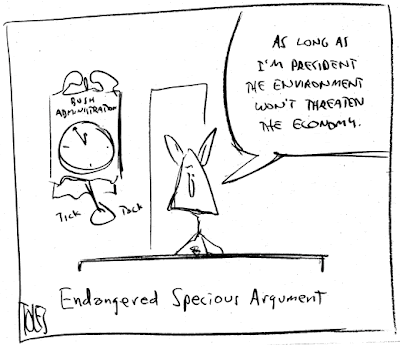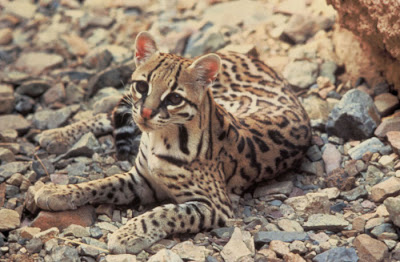 Yesterday, several news agencies reported a story about new species being discovered in Brazil. The highlight was a legless lizard of the Bachia genus (pictured left); the 13 other possible new species included a small woodpecker of the genus Picumnus. (I would love to see a picture of the new woodpecker!) Other significant finds included hyacinth macaw (Anodorhynchus hyacinthinus), Brazilian merganser (Mergus octosetaceus), and dwarf tinamou (Taoniscus nanus), all of which are threatened species.
Yesterday, several news agencies reported a story about new species being discovered in Brazil. The highlight was a legless lizard of the Bachia genus (pictured left); the 13 other possible new species included a small woodpecker of the genus Picumnus. (I would love to see a picture of the new woodpecker!) Other significant finds included hyacinth macaw (Anodorhynchus hyacinthinus), Brazilian merganser (Mergus octosetaceus), and dwarf tinamou (Taoniscus nanus), all of which are threatened species.
As the linked article mentions, the new species were discovered in Brazil's Cerrado, a wooded grassland area. The region, like many in the tropics, is a biodiversity hotspot with globally significant populations of many species. New species are constantly being discovered in such regions; I am sure that there are many more waiting to be found.
It sounds like an exciting area for research and conservation. The fly in the ointment is that, like many places in the tropics, the Cerrado is under constant threat. The region is being turned into cropland and ranchland at twice the rate of Brazil's rainforests. Why not leave it alone?
Well, the answer is that Brazilian cropland is in great demand. Brazil's Agriculture Ministry has projected record biofuel production for 2008, up to 27,400 million liters. About 4,200 million liters of that will be exported; the rest is used internally. At the same time, there is a food crisis. Part of the reason is that biofuel mandates cause cropland to be used for fuel instead of food. (Other factors include transportation costs, fertilizer shortages, and severe droughts in Australia.)
The president of Brazil denies that the current food crisis is due in any way to growing biofuel production. Other powerful people have a ready-made solution: expand agricultural land:
Blairo Maggi, the governor of Mato Grosso state and Brazil's largest soy producer, was quoted in the Folha de Sao Paulo newspaper as defending deforestation.Last year the Amazonian rain forest lost about 2,700 square miles, the first increase in deforestation in about three years. Other natural habitats face similar threats. As I have noted before on this blog, conversion of natural habitat for grain production is happening in the United States, as many farmers are taking their land out of the federal Conservation Reserve Program. When it happens here, it reduces the breeding populations of known species. When it happens in the tropics, it threatens to wipe out species with small ranges, perhaps even ones that have yet to be discovered.
"With the worsening of the global food crisis, the time is coming when it will be inevitable to discuss whether we preserve the environment or produce more food. There is no way to produce more food without occupying more land and taking down more trees," said Maggi, a farming pioneer in the vast western state who is widely known as the "King of Soy."
"In this moment of crisis, the world needs to understand that the country has space to raise its production."
Expanding cropland into Amazonian rainforest or the Cerrado is not just a threat to biodiversity; it is also a major cause of climate change. Clearing a forest releases the carbon that had been stored in the trees. Subsequent land use absorbs airborne carbon dioxide at a far lower rate than natural habitats. Reducing the impact of climate change and protecting biodiversity go hand. Existing arable land ought to be used for food rather than fuel, and existing natural habitats should be left alone as carbon sinks.



































